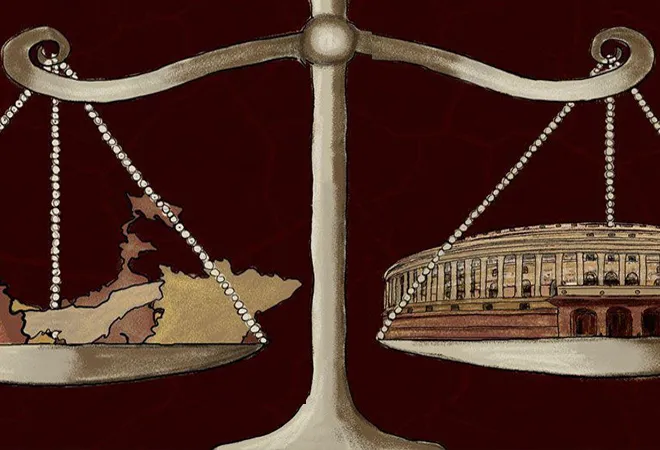
India’s federal system is one of the unique innovations of the Indian Constitution. As the Indian Constitution completes 74 years since its commencement on 26 January 1950, it is a befitting moment to assess and scrutinise the institutional arrangement that has shaped India’s federal structure. The Constitution of India provided a unique model of federalism which is often called ‘centralised federalism’. This is because, unlike the classical models of federal systems like the United States (US) or Canada, the Indian Constitution makers chose to make the Central government more powerful than the states bearing in mind the imperative of national unity at the moment of societal discord immediately after the independence. In matters concerning the creation of state boundaries, financial resources, more legislative powers and the imposition of emergency rule in the states, the Constitution has granted the Centre an upper hand.
< style="color: #163447">Setting the context
However, despite the constitutionally sanctioned superior position of the Centre in many aspects, there is clearly laid down the jurisdiction of power for the states. The states have a crucial and distinctive sphere of authority in significant policy domains in which the state governments enjoy considerable autonomy to govern. India has a very complex and diverse socio-political setting with varied concerns of resource access, distribution, and overall development. In such a context, India’s federal arrangement of some form of consociational power-sharing plays a pivotal role in ensuring coordinated as well as decentralised governance. On one hand, the centre shapes the issues of governance at the national level and acts as the chief coordinating authority amongst states on various aspects of administration. On the other hand, the state governments play a crucial role in responding to the regional and localised needs of governance at the state level. Such a balancing model of federal arrangement effectively juxtaposes the dual requirements of national integration and provincial autonomy, which is crucial in a diverse polity. This effective balance has facilitated India’s federal model to withstand and resolve some of the major complex challenges of governance that includes varied demands of autonomy, claims over material resources and other forms of contingencies.
India’s centralised federal structure, regional aspirations, and multi-party system make the need for federal interaction imperative for ensuring a cooperative model of federalism
However, India’s centralised federal structure, regional aspirations, and multi-party system make the need for federal interaction imperative for ensuring a cooperative model of federalism, both between the Centre and the states as well as amongst the states. Some of the issues like the distribution of financial and other resources to the states, the role of the Governor in the states appointed by the Union government, and the role of Central agencies in the states, many times, create institutional discord between the Centre and the states. Moreover, the distribution of resources like river water sharing or overlapping claims over territories also becomes an issue of contention amongst the states that requires amicable settlement.
< style="color: #163447">Federal Intergovernmental Institutions
In this regard, India’s federal inter-governmental institutions can provide a crucial platform of communication for the federal actors to address the outstanding issues of governance. Federal inter-governmental institutions refer to the mechanisms and channels of communication between the different levels of government in a federal system: Central, state and local governments, essential for coordinated governance. Though federal polity has largely well-defined distinctive jurisdictions of governance, there are areas of policy making and implementation which involves a great deal of convergences and requires consultations and coordination between the governments. Such inter-governmental communication can be between the Centre and the state governments as well as amongst the states. India has some well-structured provisions of inter-governmental coordination between the executive branches of the Centre and the states, both formal and informal, that are present within India’s federal system. One key inter-governmental institution for federal cooperation is the Inter-State Council (ISC) established by a presidential order in 1990 on the recommendations of the Sarkaria Commission as a platform to discuss or scrutinise policies, subjects of common interest, and disputes among states.
Another crucial platform in this regard is the Governing Council of NITI Aayog set up in 2015, as a replacement to the erstwhile Planning Commission, is comprised of the Prime Minister of India; Chief Ministers of all the States and Union Territories with the legislature; Lt Governors of other UTs; Ex-Officio Members; Vice Chairman, NITI Aayog; Full-Time Members, NITI Aayog; and Special Invitees. The body is tasked with drafting ‘a shared vision of national priorities and strategies, with the active involvement of States, in shaping the development narrative. Another very important forum is the five Zonal councils in India- Northern, Western, Eastern, Southern and Central, which were formed by the parliamentary enactment of Part III of States Reorganisation Act, 1956. These are high-level advisory bodies comprising CMs, state ministers, and government secretaries of state in each region headed by Union Home Minister. ‘Its purpose is to provide a common meeting ground in each zone for ensuring resolution of inter-state problems, fostering balanced regional development and building harmonious union-state relations.’ Later, the North-Eastern council (NEC) comprising states in the region were formed under NEC Act (1971) in 1972 initially as an advisory body but now functions as a regional planning body based on federal consultation.
< style="color: #163447">Strengthening federal dialogue
In all the crucial issues of federal governance, federal communication and dialogue is indispensable for crucial functions like coordinated planning, access of information, judicious distribution of resources, consultations and experience sharing.
This wide array of federal institutions are crucial for fostering mutual trust and constructive dialogues amongst the various federal actors. On all the crucial issues of federal governance, for instance, as contingency situation like COVID-19 has demonstrated, federal communication and dialogue is indispensable for crucial functions like coordinated planning, access of information, judicious distribution of resources, consultations and experience sharing amongst many other functions. Such institutions not only act as integral forums for planning various dimensions of federal governance but can also play a constructive role in resolving long-standing federal disputes. These institutions can be utilised by the federal stakeholders to conduct dialogue and negotiation in a relatively less-politicised environment which is crucial for addressing sensitive questions of governance that many a times, involves complex dynamics of identity and material interests. India’s model of federalism as envisaged by the Indian Constitution has stood the test of time in the last seven decades as one of the most effective models of crisis management within a diverse socio-political context and a robust federal institutional dialogue can further bolster its potential.
The views expressed above belong to the author(s). ORF research and analyses now available on Telegram! Click here to access our curated content — blogs, longforms and interviews.




 PREV
PREV


